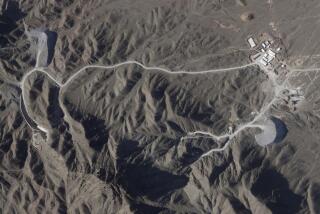Ho Chi Minhâs Bunker Opens Its Doors
HANOI â Behind thick concrete walls and iron doors, Ho Chi Minh and other top North Vietnamese leaders hid in secret underground tunnels during U.S. B-52 bombing raids and plotted key military strategies that led to the United Statesâ defeat in the Vietnam War.
For the first time, Hanoi has opened the bunker used by the late former president, military leader Gen. Vo Nguyen Giap and others. Itâs in the same building where the 1968 Tet offensive and the fall of Saigon in 1975 were planned from about 30 feet below the surface.
But the siteâs history goes far deeper than that.
Visitors are being given a rare, firsthand glimpse of nearly 1,000 years of Vietnamese history through touring the site of the Kinh Thien shrine, which dates to the 11th century.
âI feel very proud to be here and to see all these relics,â said Le Thi Mai Huong, 22, a student from Ha Tay province who is studying in Hanoi. âIt is very good for young people to visit places like this.... We can learn all the sacrifices and the suffering of the older generations who had to fight against the foreign aggressors for national independence and unification.â
The area includes two large stone dragons that extend up steps left over from the 15th century during the Le Dynasty -- all that remains of the shrine that was once part of the imperial forbidden city that was off-limits to everyone but royalty. It was rebuilt three times during different dynasties.
When the French invaded Vietnam in the late 19th century, they destroyed everything but the stairs and gate, and constructed a two-story building to house their artillery headquarters, which was taken over by the North Vietnamese after they defeated the French colonials in 1954.
The communist military, with help from the Soviets, built its headquarters there in 1967. It housed the elaborate tunnel system, including the underground bunker, which has narrow submarine-style corridors and vaulted metal doors leading into two larger rooms. During U.S. bombing raids, Politburo members and top military brass took cover there and held meetings.
Vietnamâs Defense Ministry occupied the property until recently, when it turned part of it over to the city of Hanoi. Only a small underground section of the bunker was opened to the public, with most tunnels remaining closed and classified.
âNo one knows how long [the tunnels are],â said Le Van Lan, a historian with in-depth knowledge of the site. âItâs a secret. Thereâs many legends that they go to Ho Chi Minhâs mausoleum.â
Artifacts recovered from the nearby excavation of an ancient citadel also are on display. Lan hopes that the Defense Ministry will one day hand over the entire property where the shrine once sat to allow excavation to begin. But much of the ancient treasures were probably destroyed when the bunker and tunnel system were built, he said.
About 100,000 visitors have toured the site, which has been open since Oct. 2. It also contains original war maps scribbled with handwritten notes and arrows as well as photographs taken during historic meetings held in the ground-level command room surrounded by 2 feet of concrete -- enough to withstand a missile blast.
An army blanket and simple wooden bed where Giap, now 93, sometimes napped is also on display in his old office, along with antique phones used to communicate with his staff and other officials.
âItâs a very simple room, but from that room, the Vietnamese military strategists issued big decisions for the liberation and unification of the country,â said Truong Khanh Hao, 71, a veteran who fought the French and the Americans. âItâs a pride for all Vietnamese that we have these relics.â
More to Read
Sign up for The Wild
Weâll help you find the best places to hike, bike and run, as well as the perfect silent spots for meditation and yoga.
You may occasionally receive promotional content from the Los Angeles Times.






